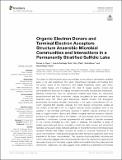| dc.contributor.author | Rojas, Connie A. | |
| dc.contributor.author | De Santiago Torio, Ana | |
| dc.contributor.author | Park, Serry | |
| dc.contributor.author | Bosak, Tanja | |
| dc.contributor.author | Klepac-Ceraj, Vanja | |
| dc.date.accessioned | 2021-09-27T14:48:03Z | |
| dc.date.available | 2021-09-27T14:48:03Z | |
| dc.date.issued | 2021-04 | |
| dc.date.submitted | 2020-10 | |
| dc.identifier.issn | 1664-302X | |
| dc.identifier.uri | https://hdl.handle.net/1721.1/132642 | |
| dc.description.abstract | The extent to which nutrients structure microbial communities in permanently stratified lakes is not well understood. This study characterized microbial communities from the anoxic layers of the meromictic and sulfidic Fayetteville Green Lake (FGL), NY, United States, and investigated the roles of organic electron donors and terminal electron acceptors in shaping microbial community structure and interactions. Bacterial communities from the permanently stratified layer below the chemocline (monimolimnion) and from enrichment cultures inoculated by lake sediments were analyzed using 16S rRNA gene sequencing. Results showed that anoxygenic phototrophs dominated microbial communities in the upper monimolimnion (21 m), which harbored little diversity, whereas the most diverse communities resided at the bottom of the lake (∼52 m). Organic electron donors explained 54% of the variation in the microbial community structure in aphotic cultures enriched on an array of organic electron donors and different inorganic electron acceptors. Electron acceptors only explained 10% of the variation, but were stronger drivers of community assembly in enrichment cultures supplemented with acetate or butyrate compared to the cultures amended by chitin, lignin or cellulose. We identified a range of habitat generalists and habitat specialists in both the water column and enrichment samples using Levin’s index. Network analyses of interactions among microbial groups revealed Chlorobi and sulfate reducers as central to microbial interactions in the upper monimolimnion, while Syntrophaceae and other fermenting organisms were more important in the lower monimolimnion. The presence of photosynthetic microbes and communities that degrade chitin and cellulose far below the chemocline supported the downward transport of microbes, organic matter and oxidants from the surface and the chemocline. Collectively, our data suggest niche partitioning of bacterial communities via interactions that depend on the availability of different organic electron donors and terminal electron acceptors. Thus, light, as well as the diversity and availability of chemical resources drive community structure and function in FGL, and likely in other stratified, meromictic lakes. | en_US |
| dc.description.sponsorship | Simons Foundation (Award 327126) | en_US |
| dc.publisher | Frontiers Media SA | en_US |
| dc.relation.isversionof | https://doi.org/10.3389/fmicb.2021.620424 | en_US |
| dc.rights | Creative Commons Attribution 4.0 International license | en_US |
| dc.rights.uri | https://creativecommons.org/licenses/by/4.0/ | en_US |
| dc.source | Frontiers | en_US |
| dc.title | Organic Electron Donors and Terminal Electron Acceptors Structure Anaerobic Microbial Communities and Interactions in a Permanently Stratified Sulfidic Lake | en_US |
| dc.type | Article | en_US |
| dc.identifier.citation | Rojas, Connie A. et al. "Organic Electron Donors and Terminal Electron Acceptors Structure Anaerobic Microbial Communities and Interactions in a Permanently Stratified Sulfidic Lake." Frontiers in Microbiology 12 (April 2021): 620424. © 2021 Rojas et al. | en_US |
| dc.contributor.department | Massachusetts Institute of Technology. Department of Earth, Atmospheric, and Planetary Sciences | en_US |
| dc.relation.journal | Frontiers in Microbiology | en_US |
| dc.eprint.version | Final published version | en_US |
| dc.type.uri | http://purl.org/eprint/type/JournalArticle | en_US |
| eprint.status | http://purl.org/eprint/status/PeerReviewed | en_US |
| dspace.date.submission | 2021-04-28T14:30:26Z | |
| mit.journal.volume | 12 | en_US |
| mit.license | PUBLISHER_CC | |
| mit.metadata.status | Complete | en_US |
